
The Ashmont–Mattapan High-Speed Line, commonly referred to as the Mattapan Trolley, is a partially grade-separated light rail line which forms part of the MBTA's Red Line rapid transit line. The line, which runs through Boston and Milton, Massachusetts, opened on August 26, 1929, as a conversion of a former commuter rail line. It exclusively uses PCC streetcars built in the 1940s. Passengers must transfer at Ashmont to access the rest of the Red Line, which uses heavy rail metro rolling stock.
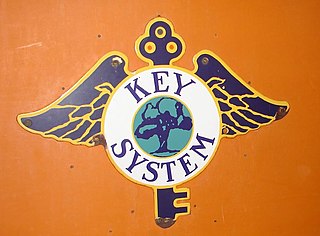
The Key System was a privately owned company that provided mass transit in the cities of Oakland, Berkeley, Alameda, Emeryville, Piedmont, San Leandro, Richmond, Albany, and El Cerrito in the eastern San Francisco Bay Area from 1903 until 1960, when it was sold to a newly formed public agency, AC Transit. The Key System consisted of local streetcar and bus lines in the East Bay, and commuter rail and bus lines connecting the East Bay to San Francisco by a ferry pier on San Francisco Bay, later via the lower deck of the Bay Bridge. At its height during the 1940s, the Key System had over 66 miles (106 km) of track. The local streetcars were discontinued in 1948 and the commuter trains to San Francisco were discontinued in 1958. The Key System's territory is today served by BART and AC Transit bus service.

The Boston, Revere Beach and Lynn Railroad was a 3 ft narrow-gauge passenger-carrying shortline railroad between East Boston and Lynn, Massachusetts, from 1875 to 1940. Part of the railroad's right of way now forms the outer section of the Massachusetts Bay Transportation Authority's Blue Line rapid transit service.

The St. Lawrence and Atlantic Railroad, known as St-Laurent et Atlantique Quebec in Canada, is a short-line railway operating between Portland, Maine, on the Atlantic Ocean, and Montreal, Quebec, on the St. Lawrence River. It crosses the Canada–US border at Norton, Vermont, and Stanhope, Quebec, and is owned by short-line operator Genesee & Wyoming.

The Troy and Greenfield Railroad, chartered in 1848, ran from Greenfield, Massachusetts, United States, to the Vermont state line. It was leased to the Troy and Boston Railroad in 1856, then consolidated into Fitchburg Railroad 1887 which in turn was acquired by Boston and Maine Railroad by lease in 1900.
The Middlesex and Boston Street Railway (M&B) was a streetcar and later bus company in the area west of Boston. Streetcars last ran in 1930, and in 1972 the company's operations were merged into the Massachusetts Bay Transportation Authority (MBTA).

Seashore Trolley Museum, located in Kennebunkport, Maine, United States, is the world's first and largest museum of mass transit vehicles. While the main focus of the collection is trolley cars (trams), it also includes rapid transit trains, Interurban cars, trolley buses, and motor buses. The Seashore Trolley Museum is owned and operated by the New England Electric Railway Historical Society (NEERHS). Of the museum's collection of more than 350 vehicles, ten trolley, and railroad cars that historically operated in Maine were listed on the National Register of Historic Places in 1980, as Maine Trolley Cars.

The Shelburne Falls Trolley Museum is a small railroad museum in Shelburne Falls, Massachusetts, United States.

Streetcars in Washington, D.C. transported people across the city and region from 1862 until 1962.

The Sacramento Northern Railway was a 183-mile (295 km) electric interurban railway that connected Chico in northern California with Oakland via the California capital, Sacramento. In its operation it ran directly on the streets of Oakland, Sacramento, Yuba City, Chico, and Woodland and ran interurban passenger service until 1941 and freight service into the 1960s.

The Electric City Trolley Museum is a transport museum located in downtown Scranton, Pennsylvania, next to the Steamtown National Historic Site. The museum displays and operates restored trolleys and interurbans on former lines of the Lackawanna and Wyoming Valley Railroad, which are now owned by the government of Lackawanna County and operated by the Delaware-Lackawanna Railroad.

The Wason Manufacturing Company was a maker of railway passenger coaches and streetcars during the 19th and early 20th century. The company was founded in 1845 in Springfield, Massachusetts by Charles Wason (1816-1888) and Thomas Wason (1811-1870). Although the concept would later be popularized by the Pullman Company, Wason was the first to manufacture sleeping cars in America.
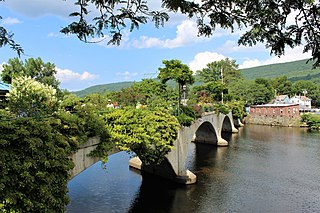
The Bridge of Flowers is in Shelburne Falls, Massachusetts, connecting the towns of Shelburne and Buckland. The seasonal footbridge – once a trolley bridge – has a garden of flowers covering it. It is only open between April and October.
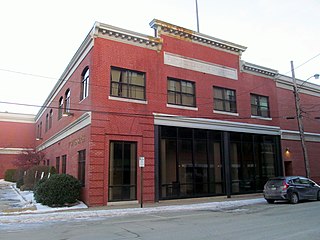
The Portland–Lewiston Interurban (PLI) was an electric railroad subsidiary of the Androscoggin Electric Company operating from 1914 to 1933 between Monument Square in Portland and Union Square in Lewiston, Maine. Hourly service was offered over the 40-mile (64 km) route between the two cities. Express trains stopping only at West Falmouth, Gray, New Gloucester, Upper Gloucester and Danville made the trip in 80 minutes, while trains making other local stops upon request required 20 minutes more. The line was considered the finest interurban railroad in the state of Maine.
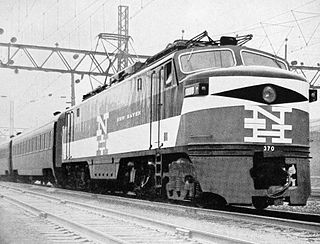
The American Flyer was an early streamlined American passenger railcar built by Pullman-Standard in the 1930s. They were the first streamlined equipment operated in New England and acquired their name from the model trains that their design inspired.
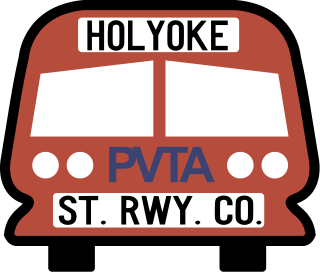
The Holyoke Street Railway (HSR) was an interurban streetcar and bus system operating in Holyoke, Massachusetts as well as surrounding communities with connections in Amherst, Belchertown, Chicopee, Easthampton, Granby, Northampton, Pelham, South Hadley, Sunderland, Westfield, and West Springfield. Throughout its history the railway system shaped the cultural institutions of Mount Tom, being operator of the mountain's famous summit houses, one of which hosted President McKinley, the Mount Tom Railroad, and the trolley park at the opposite end of this funicular line, Mountain Park.

The Manchester Street Railway was a light interurban railway that ran from Manchester to Nashua, New Hampshire.

The Turners Falls branch was a railway line in Franklin County, Massachusetts, in the United States. It ran 9 miles (14 km) from a junction with the Shelburne Falls Extension at South Deerfield, Massachusetts, to Turners Falls, Massachusetts. It was originally built in 1868 by the New Haven and Northampton Railroad, later part of the New York, New Haven and Hartford Railroad. The Boston and Maine Railroad, which had its own branch to Turners Falls, acquired the Turners Falls branch from the New Haven in 1947 and abandoned its own line. The B&M subsequently abandoned the branch in 1985. Part of it is now the Canalside Rail Trail.

The Springfield Electric Railway, affectionately referred to as the Toonerville Trolley, was an electric trolley system that operated in the city of Springfield, Vermont. The railway, which later became the Springfield Terminal Railway, was initially funded by the city in 1896 with the aim of establishing connections to the railroads passing through Charlestown, New Hampshire, across the Connecticut River. Eventually, the Boston and Maine Railroad gained control of the railway. While the trolley service ceased operations in 1947, making it the longest-running trolley in the state at that time, freight usage of the tracks ended in 1984. The Springfield Terminal name continues to exist as a subsidiary of Pan Am Railways which is now owned by CSX.


















